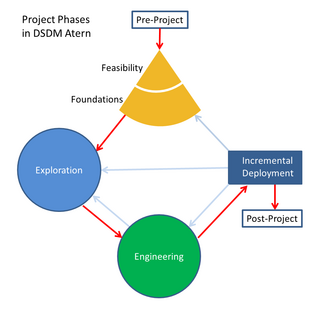
Back DSDM German Método de desarrollo de sistemas dinámicos Spanish روش توسعه سامانههای پویا Persian Dynamic Systems Development Method Finnish Dynamic systems development method French Dinamikus rendszerfejlesztés folyamata Hungarian Dynamic Systems Development Method ID Dynamic Systems Development Method Italian 동적 시스템 개발 방법 Korean Dynamic systems development method Dutch
This article has multiple issues. Please help improve it or discuss these issues on the talk page. (Learn how and when to remove these template messages)
|

| Part of a series on |
| Software development |
|---|
Dynamic systems development method (DSDM) is an agile project delivery framework, initially used as a software development method.[1][2] First released in 1994, DSDM originally sought to provide some discipline to the rapid application development (RAD) method.[3] In later versions the DSDM Agile Project Framework was revised and became a generic approach to project management and solution delivery rather than being focused specifically on software development and code creation[clarification needed][citation needed] and could be used for non-IT projects.[4] The DSDM Agile Project Framework covers a wide range of activities across the whole project lifecycle and includes strong foundations and governance, which set it apart from some other Agile methods.[5] The DSDM Agile Project Framework is an iterative and incremental approach that embraces principles of Agile development, including continuous user/customer involvement.
DSDM fixes cost, quality and time at the outset and uses the MoSCoW prioritisation of scope into musts, shoulds, coulds and will not haves to adjust the project deliverable to meet the stated time constraint. DSDM is one of a number of agile methods for developing software and non-IT solutions, and it forms a part of the Agile Alliance.
In 2014, DSDM released the latest version of the method in the 'DSDM Agile Project Framework'. At the same time the new DSDM manual recognised the need to operate alongside other frameworks for service delivery (esp. ITIL) PRINCE2, Managing Successful Programmes, and PMI.[6] The previous version (DSDM 4.2) had only contained guidance on how to use DSDM with extreme programming.
- ^ Keith Richards, Agile project management: running PRINCE2 projects with DSDM Atern. OGC – Office of Government Commerce. The Stationery Office, 31 jul. 2007.
- ^ Plonka, Laura, et al. "UX Design in Agile: A DSDM Case Study." Agile Processes in Software Engineering and Extreme Programming. Springer International Publishing, 2014. 1-15.
- ^ Abrahamsson, Pekka, et al. "New directions on agile methods: a comparative analysis Archived 2018-10-24 at the Wayback Machine." Software Engineering, 2003. Proceedings. 25th International Conference on. Ieee, 2003.
- ^ Stapleton, Jennifer (January 2003). Business Focused Development. Pearson Education. p. 113. ISBN 9780321112248.
- ^ Moran, Alan (March 2015). Managing Agile. Springer. pp. 21–24. ISBN 9783319162614.
- ^ The DSDM Agile Project Framework manual, 2014 pages 4, 16
© MMXXIII Rich X Search. We shall prevail. All rights reserved. Rich X Search